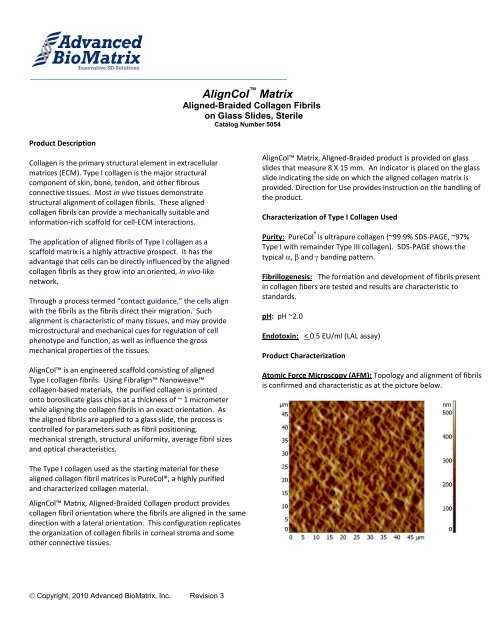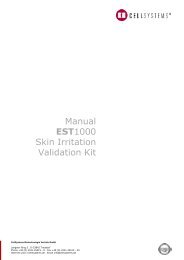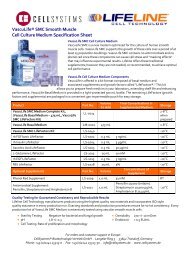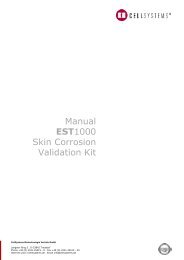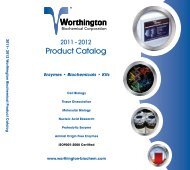Directions for Use - Advanced BioMatrix
Directions for Use - Advanced BioMatrix
Directions for Use - Advanced BioMatrix
You also want an ePaper? Increase the reach of your titles
YUMPU automatically turns print PDFs into web optimized ePapers that Google loves.
AlignCol Matrix<br />
Aligned-Braided Collagen Fibrils<br />
on Glass Slides, Sterile<br />
Catalog Number 5054<br />
Product Description<br />
Collagen is the primary structural element in extracellular<br />
matrices (ECM). Type I collagen is the major structural<br />
component of skin, bone, tendon, and other fibrous<br />
connective tissues. Most in vivo tissues demonstrate<br />
structural alignment of collagen fibrils. These aligned<br />
collagen fibrils can provide a mechanically suitable and<br />
in<strong>for</strong>mation-rich scaffold <strong>for</strong> cell-ECM interactions.<br />
The application of aligned fibrils of Type I collagen as a<br />
scaffold matrix is a highly attractive prospect. It has the<br />
advantage that cells can be directly influenced by the aligned<br />
collagen fibrils as they grow into an oriented, in vivo-like<br />
network.<br />
Through a process termed “contact guidance,” the cells align<br />
with the fibrils as the fibrils direct their migration. Such<br />
alignment is characteristic of many tissues, and may provide<br />
microstructural and mechanical cues <strong>for</strong> regulation of cell<br />
phenotype and function, as well as influence the gross<br />
mechanical properties of the tissues.<br />
AlignCol is an engineered scaffold consisting of aligned<br />
Type I collagen fibrils. Using Fibralign Nanoweave<br />
collagen-based materials, the purified collagen is printed<br />
onto borosilicate glass chips at a thickness of ~ 1 micrometer<br />
while aligning the collagen fibrils in an exact orientation. As<br />
the aligned fibrils are applied to a glass slide, the process is<br />
controlled <strong>for</strong> parameters such as fibril positioning,<br />
mechanical strength, structural uni<strong>for</strong>mity, average fibril sizes<br />
and optical characteristics.<br />
AlignCol Matrix, Aligned-Braided product is provided on glass<br />
slides that measure 8 X 15 mm. An indicator is placed on the glass<br />
slide indicating the side on which the aligned collagen matrix is<br />
provided. Direction <strong>for</strong> <strong>Use</strong> provides instruction on the handling of<br />
the product.<br />
Characterization of Type I Collagen <strong>Use</strong>d<br />
Purity: PureCol ® is ultrapure collagen (~99.9% SDS-PAGE, ~97%<br />
Type I with remainder Type III collagen). SDS-PAGE shows the<br />
typical , and banding pattern.<br />
Fibrillogenesis: The <strong>for</strong>mation and development of fibrils present<br />
in collagen fibers are tested and results are characteristic to<br />
standards.<br />
pH: pH ~2.0<br />
Endotoxin: < 0.5 EU/ml (LAL assay)<br />
Product Characterization<br />
Atomic Force Microscopy (AFM): Topology and alignment of fibrils<br />
is confirmed and characteristic as at the picture below.<br />
The Type I collagen used as the starting material <strong>for</strong> these<br />
aligned collagen fibril matrices is PureCol®, a highly purified<br />
and characterized collagen material.<br />
AlignCol Matrix, Aligned-Braided Collagen product provides<br />
collagen fibril orientation where the fibrils are aligned in the same<br />
direction with a lateral orientation. This configuration replicates<br />
the organization of collagen fibrils in corneal stroma and some<br />
other connective tissues.<br />
Copyright, 2010 <strong>Advanced</strong> <strong>BioMatrix</strong>, Inc. Revision 3
Storage: This product is stored and shipped at ambient or room<br />
temperature.<br />
Stability: The product shelf life is 24 months.<br />
Cell Attachment and Growth Assay: To demonstrate cell<br />
attachment and alignment, cells are seeded on the aligned matrix<br />
and meet criteria.<br />
Precautions and Disclaimer<br />
This product is <strong>for</strong> R&D use only and is not intended <strong>for</strong> human or<br />
other uses. Please consult the Material Safety Data Sheet <strong>for</strong><br />
in<strong>for</strong>mation regarding hazards and safe handling practices.<br />
Procedure<br />
1. AlignCol Matrix is supplied sterile in a container. Using sterile<br />
<strong>for</strong>ceps, remove the AlignCol Matrix slide from the container by<br />
gripping the end of the slide ensuring that the <strong>for</strong>ceps do not<br />
disturb the matrix portion of the slide.<br />
2. Upon removal of the slide, check <strong>for</strong> the right-side up<br />
orientation of the matrix. An indicator is placed on the glass slide<br />
indicating the side on which the aligned collagen matrix is<br />
provided.<br />
3. Dip AlignCol Matrix slide into DPBS without Ca and Mg <strong>for</strong><br />
5 minutes and remove.<br />
4. Immediately dip and rinse AlignCol Matrix slide into de-ionized<br />
water using a gentle motion <strong>for</strong> 5-10 seconds and remove.<br />
5. Immediately immerse AlignCol Matrix slide into sterile 70%<br />
ethanol <strong>for</strong> minimum of 1 hour to sterilize and remove.<br />
6. Place the AlignCol Matrix slide in a new culture dish and let it<br />
dry. Positioning the slide at an angle against the wall (not flat on<br />
the bottom) allows <strong>for</strong> the ethanol to evaporate faster. Once<br />
dried, place the slide flat on the bottom of the culture dish with<br />
the orientation of the matrix in the up position. Alternatively,<br />
rinse the e slide 3 times with PBS or DMEM (e.g., 3 ml <strong>for</strong> one well<br />
of 6-well plate) ensuring that the orientation of the matrix is in the up<br />
position.<br />
8. Remove DMEM and add cell suspension in DMEM without<br />
serum into the culture system.<br />
9. After cells attach, remove the DMEM and replace with complete<br />
cell culture medium (e.g. DMEM with serum).<br />
List of References<br />
1. E. Vrana, N. Builles, M. Hindie, O. Damour, A. Aydinli, V. Hasirci, "Contact<br />
guidance enhances the quality of a tissue engineered corneal stroma",<br />
Journal of Biomedical Materials Research Part A, 84, Issue 2 , 2008, 454 –<br />
463.<br />
2. L. Besseaua, B. Coulombb, C. Lebreton-Decosterb, M.-M. Giraud-Guillec,<br />
"Production of ordered collagen matrices <strong>for</strong> three-dimensional cell<br />
culture", Biomaterials, 23, 2002, 27–36.<br />
3. Cheng Guo, Laura J. Kaufman, "Flow and magnetic field induced collagen<br />
alignment", Biomaterials, 28, 2007, 1105–1114.<br />
4. C. Helarya, L. Ovtrachta, B. Coulombb, G. Godeaub, M. M. Giraud-Guille,<br />
"Dense fibrillar collagen matrices: A model to study myofibroblast<br />
behaviour during wound healing", Biomaterials, 27, 2006, 4443–4452.<br />
5. P. P. Provenzano, K. W. Eliceiri, J.M. Campbell, D. R. Inman, J. G. White,<br />
and P. J. Keely, "Collagen reorganization at the tumor-stromal interface<br />
facilitates local invasion", BMC Medicine, 4:38, 2006.<br />
6. K. Yoshizato, T. Obinata, H.-Yh Huang, R. Matsuda, N. Shioya, and T.<br />
Miyata, "In Vitvo Orientation of Fibroblasts and Myoblasts on Aligned<br />
Collagen Film", Develop., Growth and Differ., 23 (2), 1981, 175-184.<br />
7. H. J. Evans, J. K. Sweet, R. L. Price, M. Yost, and R. L. Goodwin, "Novel 3D<br />
culture system <strong>for</strong> study of cardiac myocyte development", Am J Physiol<br />
Heart Circ Physiol 285, 2003, H570–H578.<br />
8. N. Dubey, P. C. Letourneaub, R. T. Tranquillo, "Neuronal contact guidance<br />
in magnetically aligned fibrin gels: effect of variation in gel mechanostructural<br />
properties", Biomaterials, 22, 2001, 1065-1075.<br />
9. B. I. Rosner, T. Hang, R.T. Tranquillo, "Schwann cell<br />
behavior in three-dimensional collagen gels: evidence <strong>for</strong> differential<br />
mechano-transduction and the influence of TGF-beta 1 in morphological<br />
polarization and differentiation", Exp Neurol, 195, 2005, 81-91.<br />
10. H. Haga, C. Irahara, R. Kobayashi, T. Nakagaki, and K. Kawabata,<br />
"Collective Movement of Epithelial Cells on a Collagen Gel Substrate",<br />
Biophysical Journal, 88, 2005, 2250–2256.<br />
11. Lee P, Lin R, Moon J, Lee L P., "Microfluidic alignment of collagen fibers<br />
<strong>for</strong> in vitro cell culture", Biomed Microdevices, 8, 2006, 35–41.<br />
12. Y.-R. V. Shih, C.-N. Chen, S.-W. Tsai, Y. J. Wang, O. K. Lee, "Growth of<br />
Mesenchymal Stem Cells on Electrospun Type I Collagen Nanofibers",<br />
Stem Cells, 24, 2006, 2391-2397.<br />
13. G. G. Fuller, Langmuir-Blodgett films of oriented collagen films as cell<br />
culture substrates, 81st ACS Colloid & Surface Science Symposium, June<br />
2007.<br />
7. Pre-incubate the slide in DMEM <strong>for</strong> 45 minutes at 37°C in a CO 2<br />
incubator.<br />
Copyright, 2010 <strong>Advanced</strong> <strong>BioMatrix</strong>, Inc. Revision 3


